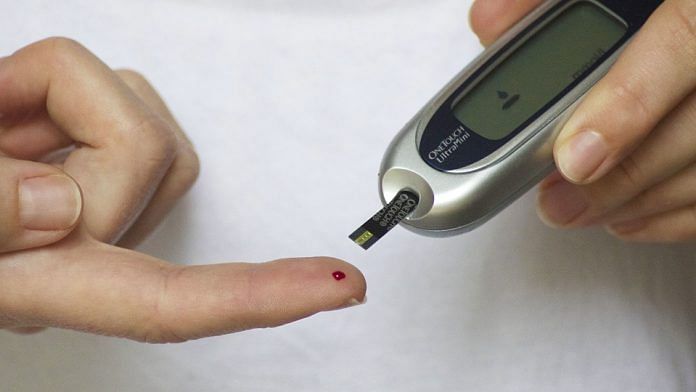New Delhi: A thin man with normal weight but unhealthy lifestyle. An obese woman in her 20s with no family history of diabetes. A retiree in his late 60s: If all three of these people are diagnosed with type-2 diabetes, would the nature and severity of their ailment be the same?
Doctors think it may well not be, with some saying that Indian patients of type-2 diabetes suffer from as many as seven variants that are currently being diagnosed as one.
Less than a year after a landmark Swedish study sought to expand diabetes diagnosis —currently restricted to type-1 and type-2 — to five variants, Indian researchers in January initiated an India-centric examination to reclassify the disease into more subgroups.
Started at the Pune-based KEM hospital in collaboration with the Swedish Medical Research Council, the project is an extension of the Swedish study — ANDIS — which covered all newly-diagnosed diabetics in southern Sweden, totalling nearly 14,000. It was published last March in The Lancet Diabetes & Endocrinology.
Diabetes is a chronic disease where the body fails to produce the hormone insulin, which controls blood sugar, or is unable to use it efficiently. As of 2017, India had approximately 7.2 crore diabetes patients, with the number expected to swell to 13.4 crore by 2025.
Doctors hope the study will help deliver targeted, more effective treatment to high-risk patients of the disease, which, according to the World Health Organisation (WHO), can cause a whole range of complications in its extreme forms, including blindness, kidney failure, heart attacks, stroke and lower limb amputation.
India recognises the disease as a serious public health challenge. According to data from the Ministry of Health and Family Welfare, diabetes is the country’s fastest growing disease, with India currently representing nearly half the world’s diabetes burden.
Also read: 98 million Indians likely to have diabetes type 2 by 2030: Lancet study
For tailored treatment
The Indian study is being led by Dr Chittaranjan S. Yajnik, the head of the diabetes unit at KEM Hospital.
The first phase of the project involves the data of 3,000 diabetes patients collected at KEM Hospital over the past 15 years.
The data includes information about the age of patients, their body mass index, actual levels of insulin in blood, and damage to pancreatic cells [which produce insulin] — the same parameters used in the Swedish study.
“Based on these parameters, the objective of the first stage is to identify the sub-groups in India, which is likely to be completed in three to six months,” Dr Yajnik told ThePrint.
“In the second stage, we will work to find out the treatment options for each sub-type. If successful, the study will personalise the treatment options for every group,” he added.
“Instead of providing the same treatment protocol based on measuring blood glucose levels, the new groups will help doctors predict the complications, adjust medication, and adopt preventive measures from the very first day of treatment,” said Dr Yajnik.
The study is funded by the government of India’s Department of Science and Technology, and Swedish Research Council, the European country’s largest research funding body and also a backer of the 2018 study.
Also read: Daily physical activity, healthy diet must to prevent diabetes among teenagers
More sub-groups
Currently, diabetes is just diagnosed under two groups — type-1 and type-2. While type-1 is described as one characterised by a lack of insulin production, type-2 diabetes stems from the hormone’s ineffective use of insulin.
The Swedish study expanded the range to five — severe autoimmune diabetes, severe insulin-deficient diabetes, severe insulin-resistant diabetes, mild obesity-related diabetes, and mild age-related diabetes.
Doctors in India expect the range to widen further for Indian patients.
“The scenario is likely to be different in India as we might have more subgroups,” said Dr Anoop Misra, chairman, Fortis-C-DOC Centre of Excellence for Diabetes.
“One such [sub-group] that we keep on seeing is thin patients [as opposed to obese patients, who are common] with type-2 diabetes, who need totally different emphasis on some drugs,” he added.
Dr Mahesh D.M., a consultant in endocrinology at Aster CMI Hospital, Bengaluru, said the study was likely to find “five or more types of diabetes”.
“Diabetes, apart from type-1 and 2, is already informally classified into secondary diabetes which includes genetic diabetes, pancreatic diabetes, lifestyle diabetes and many more,” he added.
“There can be more than 20 reasons why a person is diabetic. Hence, the research is likely to find five or more types of diabetes,” he said.
Dr Vineet Kumar Surana, consultant, Diabetes and Endocrinology at Manipal Hospitals in Dwarka said that besides a totally different genetic pool of Indians against the Swedish, the former have completely different eating patterns which is likely to add up to the list of causes.
“More than half of our diet is full of carbohydrates, which is not the case among the Swedish population. If we get a reliable data set to re-classify the types of diabetes here, it is very much likely that we may see more than five sub-types of diabetes in India.”
Study leader Yajnik did not comment on the number of sub-groups the Indian study is likely to throw up, but said they were “expecting different results in the Indian studym given the difference in Indian and Swedish genes”.
“Indians are diagnosed with the disease at a younger age and with lower body mass index, which is likely to yield different results,” he added.






